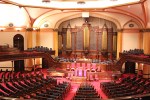

The subject of vocation returned to Minneapolis’ Westminster Presbyterian Church on February 9th. A prior post examined the service’s music on the subject while another set forth the Scriptures for the day: Psalm 27 and Matthew 4:12-23.[1]
The sermon that day was “What Happens When Jesus Calls?” by Rev. Dr. Timothy Hart-Andersen, the Senior Pastor.Here are excerpts from that sermon.
“If the question is what happens when Jesus calls, the answer may be that when Jesus calls we take a good, long, hard, deep look at what we perceive to be the purpose of our lives. That may suggest a job change, or not; perhaps a shift in careers, or not; it may mean finally discovering our life’s vocation.
The fishermen on the Sea of Galilee have that kind of experience with Jesus when he comes calling. His goal is not that they abandon their chosen vocation arbitrarily, but, rather, to rethink it. He never asks them to stop fishing; he asks them to rethink how and why they are doing it. In fact, Jesus even says to them that they’ll continue in the same line of work – only now they’ll be ‘fishing for people.’ He wants them to ponder who they are and what their focus ought to be in life.
When Jesus calls, it occasions an examination of our purpose in life, no matter what work we’re engaged in. In the story of Jesus calling the fishermen at least two things happen.
First, Jesus comes looking for them. The call is his idea, not theirs. They were minding their own business when he shows up and invites them to rethink their lives. We don’t have to take the first step toward Jesus; he comes for us, if we’re ready. This is what the psalmist refers to in writing, ‘Wait for the Lord. Be strong. Wait for the Lord.’
So often we think the business of faith depends on us; but it’s a gift from God, not an achievement we attain through hard work and hours of effort. Jesus comes looking for us.
Second, Jesus meets them right where they are. He looks for ordinary people who live ordinary lives. Those four fishermen had no apparent special gifts that made them uniquely attractive candidates to become disciples.
The Church will be built not of princes and priests and power brokers, but of common people who are just like anyone else. Those fishermen went from their boats to become the inner circle of Jesus and later to lead the early Church. Nothing about them suggested that they would be suited for this work. Jesus meets us right where we are.
The call Jesus extends to the fishermen changes them. We who want to follow Jesus without making much in the way of change in our lives, be it in how we conduct our business, or how we spend our time, or how we use our resources, are missing the whole point of Christianity. Faith transforms us. The old life is gone; a new life has begun.
Understanding what it means to be called, to have a vocation, is at the heart of the Presbyterian way of Christianity. Writing in the 16th century, John Calvin said.
- ‘The Lord bids each one of us in all life’s actions to look to his (or her) calling. For God knows with what great restlessness human nature flames, with what fickleness it is borne hither and thither, how its ambition longs to embrace various things at once.’
Calvin may be giving us a peek inside his own personality and psychological make-up when he names the ‘great restlessness’ of human nature. But many of us know precisely what Calvin refers to when he laments the way we flit about from one scheme to another as we seek to find what we’re supposed to be doing in life. Especially today, it’s difficult to know what direction to pursue when our vocation in ten years – or even in one year – may not even exist right now.
‘Therefore,’ Calvin goes on to say, ‘Each individual has his (or her) own kind of living assigned to him (or her) by the Lord as a sort of sentry post so that he (or she) may not heedlessly wander throughout life.’ (John Calvin; Institutes, III.x.6.)
‘Our own kind of living assigned to us so that we might not heedlessly wander throughout life.’
These days the average person will hold between 10 and 15 jobs in a lifetime. I was heading in that direction myself until I finally gave into the nagging sense of call to serve the church. I started seminary at age 27; by that time I had made several exploratory attempts – at least three – to test one career or another, None of them was right. I was having a hard time finding the ‘kind of living assigned to me.’ I was wandering.
Finding my vocation, my calling, depended on my feeling at home in what I was doing. I resisted accepting the call to ministry as long as I could, but in each vocation I tested – teacher, academic scholar, social service worker– I felt as if I were a stranger, as if were not quite at home. Frankly, it also had to do with needing to be sure it was my call and not something I was doing to please someone else – my parents, in particular. [2]
When I was in my mid-20’s, some 15 years later, with my life in a time of upheaval, I began, finally, to consider what I had avoided all those years: whether or not I was called into ministry. I wrestled hard with the decision– for nine months, in a kind of gestating process, I prayed and listened.
And one September Saturday morning, as I was in the bath tub, it came to me that I needed to go to seminary. The water was making a deep connection, I realized later, between baptism and vocation.
Ordained ministry was the one possibility that didn’t leave me feeling as if I were a stranger. It felt like home.
I was finding my vocation, not what my parents wanted me to do, but what I felt called to do.
Think back on your own employment history; you may be surprised how many different jobs you’ve held or careers you’ve tried, but that may or may not have anything to do with the ‘heedless wandering’ Calvin was concerned about. Christian vocation is less about a particular job and more about how we approach that job, less about what career we choose and more about the underlying purpose we sense in our lives, and how that purpose manifests itself in whatever work we do.
Nothing more thrills a pastor than to see changes happening in the lives of parishioners. I’ve seen hard-charging business leaders switch to non-profit careers because they feel called to serve the community in a new way. I’ve seen teachers give themselves over utterly to their students because they sense a call to live like that. I’ve watched retired people discover new ways to serve and follow Jesus in their later years. I’ve seen young adults light up as they discover their vocation and pursue it with determination.
When Jesus calls we get up and go, stepping forward in the direction of the one calling us. Being a follower of Jesus is not a destination; that’s what those fishermen learned that day. Being called to follow Jesus is a way of life, a pilgrimage on which we embark together.
The occasion of a memorial service – any memorial service, not only that of a much-loved public figure [like Joan Mondale][3] – invites us to reflect not only on the life of the one who has died, but also on the life you and I lead.
Someday it will be we about whom they will be speaking. What will they say? What will be the summary of the highest priorities of our lives? What will they say was the central theme of our lives?
Thanks be to God.”
[1] The bulletin, a copy of the sermon and an audio and video recording of the service are available online as are the ones for the January 26th service about vocation. Prior posts have discussed that service’s (a) Prayer of Confession; (b) an anthem beginning with the words “God be in my head;” (c) passages from the Bible’s book of Acts and the sermon’s drawing on them for comments concerning the vocations of Tabitha, Peter, Lydia and Paul; (d) a passage from Paul’s epistle from a Roman prison and the sermon’s drawing on them for comments about the preacher’s and her people’s vocations; (e) a hymn, “How Clear Is Our Vocation, Lord;” (f) another hymn, “Give Thanks, O Christian People;” and (g) an anthem, “Forth in Thy Name, O Lord, I Go.” Clicking on “Westminster Presbyterian Church” in the Tag Cloud at the top right of the blog will give you all of the posts about the church in reverse chronological order of posting.
[2] Rev. Hart-Andersen’s father–Rev. Dr. Henry William Andersen–was an esteemed Presbyterian minister, who died last year.
[3] The prior day Rev. Dr. Hart-Andersen had presided at the memorial service at Westminster for long-time member and former Second Lady Joan Mondale, with remembrances from friends and acquaintances, including Vice President Joe Biden and former President Jimmy Carter. Included in the 1,000 people at the service were her husband and former Vice President Walter Mondale, Minnesota Governor Mark Dayton (who is a Westminster member), two U.S. Senators, half the Minnesota congressional delegation, several mayors, brass and strings from the Minnesota Orchestra, the Macalester College Choir and Pipe Band, gospel musicians, and a Japanese solo vocalist Another 5,000 people, including this blogger, attended via the live-stream video, which is available online.












